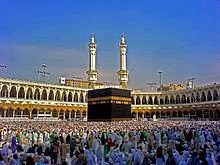
Tuesday, October 1, 2013
HAJJ
Hajj (Arabic: حج Ḥaǧǧ "pilgrimage") is an Islamic pilgrimage to Mecca and the largest gathering of Muslim people in the world every year. It is one of the five pillars of Islam, and a religious duty which must be carried out by every able-bodied Muslim who can afford to do so at least once in his or her lifetime.The state of being physically and financially capable of performing the Hajj is called istita'ah and a Muslim who fulfils this condition is called a mustati. The Hajj is a demonstration of the solidarity of the Muslim people, and their submission to God (Allah in the Arabic language).
The pilgrimage occurs from the 8th to 12th Dhu al-Hijjah, the 12th and last month of the Islamic calendar. Because the Islamic calendar is a lunar calendar, eleven days shorter than the Gregorian calendar used in the Western world, the Gregorian date of the Hajj changes from year to year. Ihram is the name given to the special spiritual state in which Muslims live while on the pilgrimage. The calendar is from 8th to 12th because that's the calendar of the Muslims.
The Hajj is associated with the life of the Islamic Prophet Muhammad from the 7th century, but the ritual of pilgrimage to Mecca is considered by Muslims to stretch back thousands of years to the time of Abraham (Ibrahim). Pilgrims join processions of hundreds of thousands of people, who simultaneously converge on Mecca for the week of the Hajj, and perform a series of rituals: Each person walks counter-clockwise seven times around the Ka'aba, the cube-shaped building which acts as the Muslim direction of prayer, runs back and forth between the hills of Al-Safa and Al-Marwah, drinks from the Zamzam Well, goes to the plains of Mount Arafat to stand in vigil, and throws stones in a ritual Stoning of the Devil. The pilgrims then shave their heads, perform a ritual of animal sacrifice, and celebrate the three day global festival of Eid al-Adha.
History
he Hajj is based on a pilgrimage that was ancient even in the time of Muhammad in the 7th century. According to tradition, elements of the Hajj trace back to the time of Abraham (Ibrahim), around 2000 BCE. Abraham's wife, Sarah, was unable to conceive, and upon her request, Abraham had taken their female servant, Hagar, as a second wife. Hagar bore Abraham a son, Ishmael. It is believed that Abraham was ordered by God to leave Hagar (Hājar) and Ishmael (ʼIsmāʻīl) alone in the desert. Looking for shelter, food and water, Hagar ran back and forth between the hills of Safa and Marwa seven times with her son. In desperation, she laid the baby on the sand and begged for God's assistance. The baby cried and hit the ground with his heel (some versions of the story say that the angel Gabriel (Jibrail) scraped his foot or the tip of his wing along the ground), and the Zamzam Well miraculously sprang forth.
In 630 CE, Muhammad led his followers from Medina to Mecca, it was the first Hajj to be performed by Muslims alone, and the only Hajj ever performed by Muhammad. He cleansed the Kaaba, destroyed all the idols, and re-ordained the building as the house of God. It was from this point that the Hajj became one of the Five Pillars of Islam.
Performing Hajj was a hazardous journey for early pilgrims; Ibn Jubayr noted the skeletons of pilgrims who had died of thirst during the journey. In the seventeenth century a group of Egyptian pilgrims lost over 1,500 people and 900 camels. In 1924 around one-fifth of a group of Syrian pilgrims died and two years later 12,000 are thought to have died during the journey.
Preparations
See also: Ihram
During the Hajj, male pilgrims are required to dress only in the ihram, a garment consisting of two sheets of white unhemmed cloth, with the top draped over the torso and the bottom secured by a white sash; plus a pair of sandals. Women are simply required to maintain their hijab—normal modest dress, which does not cover the hands or face.
The Ihram is meant to show equality of all pilgrims, in front of God: there is no difference between a prince and a pauper. Ihram is also symbolic for holy virtue and pardon from all past sins. A place designated for changing into Ihram is called a Miqat ( like Zu 'l-Hulafa, Juhfa, Qarnu 'l-Manāzil, Yalamlam, Zāt-i-'Irq, Ibrahīm Mursīa).
While wearing the Ihram, a pilgrim may not shave, clip their nails, wear perfume, swear or quarrel, have sexual relations, uproot or damage plants, kill or harm wild animals, cover the head [for men] or the face and hands [for women], marry, wear shoes over the ankles, or carry weapons.
Subscribe to:
Posts (Atom)




